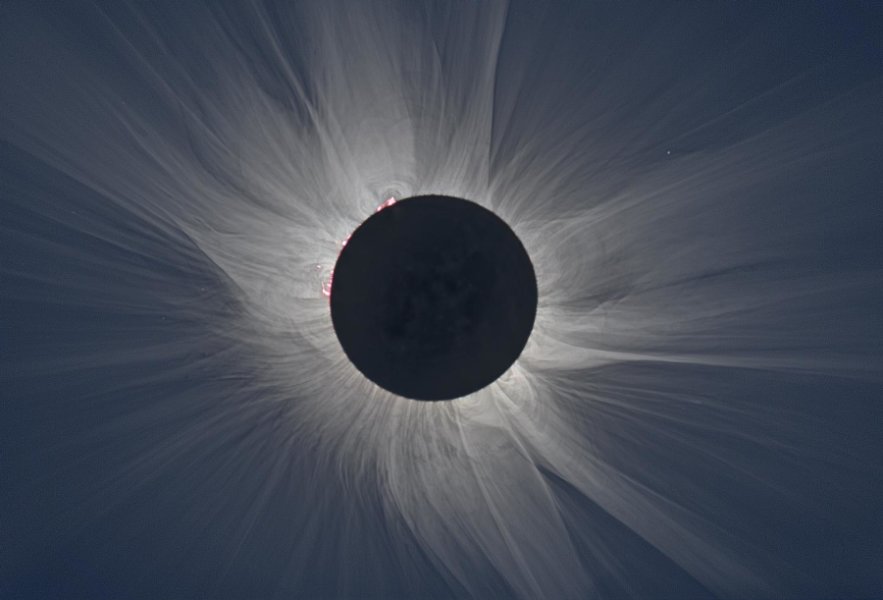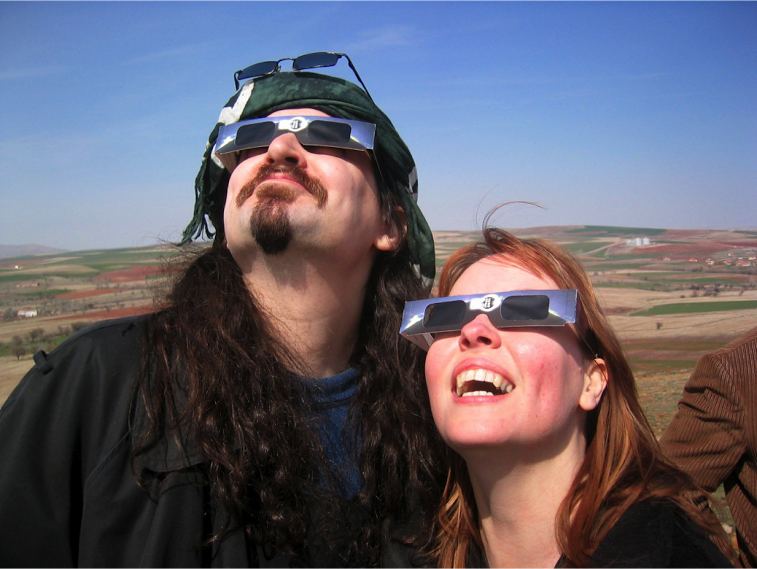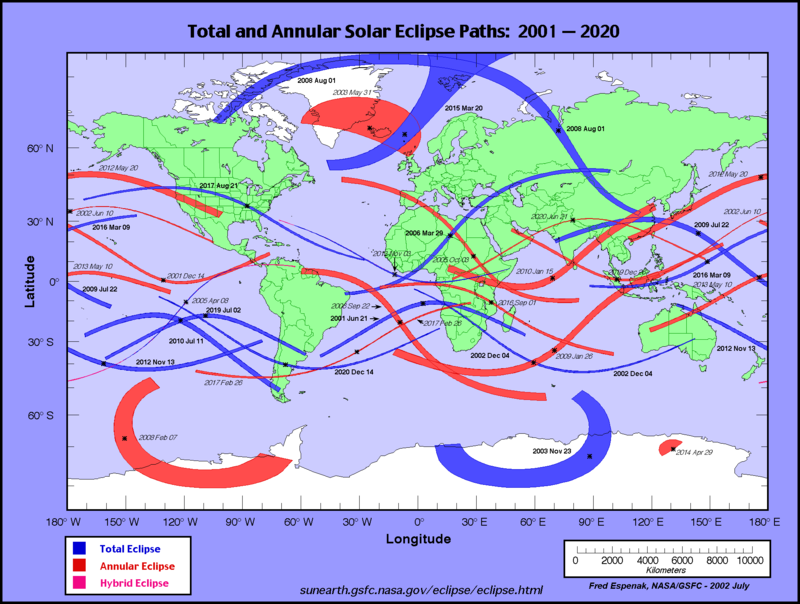Inside the Thriving Subculture of Eclipse Chasers
Credit to Author: Becky Ferreira| Date: Mon, 07 Aug 2017 14:00:00 +0000
Imagine if you let your future travel plans be charted out by the grand orbital dance between the Moon, the Sun, and Earth. For eclipse chasers, a growing subculture of umbraphiles who seek the shade cast by total solar eclipses, these cosmically predestined voyages are a way of life.
Many people have witnessed lunar eclipses, where Earth’s shadow dims the Moon, or a partial solar eclipse, where the Moon blots out part of the Sun. But true eclipse devotees roam the world hunting the big celestial game—the so-called “path of totality.” This is the thin cut of land graced by a lunar umbra (or shadow) during a total solar eclipse, like the one that will bisect the continental United States on August 21, two weeks from now.
Total solar eclipses occur every 18 months on average, but the Moon’s shadow is often cast in inconvenient or remote locations. That’s what makes the upcoming eclipse so unique: The continental US has not seen a total solar eclipse since 1979, and won’t see one again until 2024.
An estimated 12 million people live within the path of totality, which runs from Oregon to South Carolina. Millions more are expected to visit the narrow band of land, which is charted out in this visualization from NASA:
August 2017 path of totality. Video: NASA Goddard/YouTube
Only within the path of totality will the Moon fully occult the Sun, plunging daylight into darkness and exposing the Sun’s mesmerizing outer atmosphere, known as the solar corona, for up to two minutes and 40 seconds on August 21.
“It looks like there’s a hole in the sky where the Sun should be, and also it looks like there’s an eye looking down at you,” Kate Russo, a psychologist, author, and eclipse enthusiast with ten past solar eclipses under her belt, told me over Skype. “You can completely understand how our primitive ancestors would have felt like it was the end of the world.”
Indeed, ancient peoples marveled at these spectacular events, and frequently interpreted them as divine messages from otherworldly beings. Over the centuries, as astronomers decoded the mechanics behind such fortuitous orbital alignments, accurate eclipse predictions became possible, and that advance sparked many important scientific breakthroughs.
“If there hadn’t been eclipses, I don’t know how long it would have taken scientists to discover that stars have an outer atmosphere,” Shadia Habbal, co-chair of the American Astronomical Society’s Solar Eclipse Task Force and a solar physicist at the University of Hawaii’s Institute for Astronomy, told me over the phone.
“You have all this dark sky that allows you to see the corona, which is like looking at stars in the daytime,” she said. “That’s what’s so unique about the circumstance of an eclipse. Even with all our technology, we cannot beat that.”
The Moon’s umbra cast on Earth during the 2016 solar eclipse. GIF: NASA Earth Observatory/DSCOVR/EPIC
Habbal is an avid eclipse chaser who has visited 14 paths of totality over 22 years, located everywhere from the Libyan Sahara desert to Norway’s Arctic Svalbard islands. The first eclipse she witnessed, a 1995 totality over India, still looms the largest in her memory, especially the detail of the coronal structures called streamers that form over the Sun, which are exposed during an eclipse.
“I had the feeling that the streamers were going out into infinity,” Habbal said. “I’ve never had the experience again since.”
Habbal now heads an expedition crew called the Solar Wind Sherpas, so named because they schlep heavy equipment—digital SLR cameras, special astrophotography instruments, spectrometers, and multiple filters and lenses—to paths of totality around the world. According to the team’s blog posts about the 2016 total eclipse in Indonesia, they brought so much luggage and observational hardware that the check-in process single-handedly delayed their flight to Jakarta.
Weather conditions sometime rule out clear views of events, a wild card factor that has hindered the results of five out of Habbal’s 14 eclipse-viewing trips. The possibility of cloud cover is a gamble eclipse chasers simply have to accept when they book their tickets.
Still, all the hard work and uncertainty seems to pay off more often than not. With every new successful viewing of the corona during total eclipses, Habbal and her colleagues are working toward solving perplexing mysteries about our star, such as the so-called “coronal heating problem.”
At millions of degrees Celsius, the solar corona is exponentially hotter than the surface of the Sun, which hovers around 6,000 ℃. Why? Nobody knows. But this phenomenon has huge implications for understanding the dynamics of the Sun and the solar wind, which dramatically impact the solar system’s planets, including Earth.
“This is the first time a generation of Americans will be able to see a total solar eclipse”
“To understand why the corona is hot, we need this information that is provided by eclipses,” Habbal told me. “[The corona] is not just like one big blob that’s two million degrees. It has features that are at different densities and temperatures, which translates into different types of solar wind that flows into interplanetary space.”
To map out these complexities, Habbal and her Solar Wind Sherpas capture eclipses across multiple wavelengths of light to track the abundance of particular ionized elements like iron-11 or iron-14, which provide information about temperature distribution. Every new observation of totality yields a more detailed picture of the Sun and the solar wind. But this data also raises fresh questions.
“We are still discovering new things that we don’t understand,” Habbal said. For instance, the team observed relatively cool coronal material during the 2015 Svalbard eclipse that, for some reason, remained cool in spite of the high temperatures surrounding it. “Now, we have new puzzles in the coronal heating problem.”

This zest for discovery, combined with the sheer spectacle of totality, is what keeps scientists like Habbal returning to the Moon’s shadow, wherever it may fall.
“The beauty of the eclipse is something I hope as many people as possible can witness,” she told me, “but then you go beyond that experience. Light coming from our star, and from the corona, is the only tool we have to understand what’s going on in this distant object.”
Likewise, Russo’s self-described “addiction” to total solar eclipses led to a professional career, but her focus is on the lived personal experiences of those who see them. She consults communities located within paths of totality, and has written extensively about the transformative psychological experience of witnessing total solar eclipses, from first-timers to veteran umbraphiles.
“The experience is just so powerful that it becomes a major driving force in our lives,” said Russo, describing eclipse-heads. “It’s like we have no choice about it.”

In her book Total Addiction: The Life of an Eclipse Chaser, she coined the handy acronym “SPACED” to describe the sequence of reactions many people commonly go through as the Moon fully occults the Sun: A Sense of wrongness, Primal fear, Awe, Connection, Euphoria, and the Desire to repeat the experience.
“There is such a commonality of emotions that I realized it wasn’t just me,” Russo told me. “The similarity across accounts is really fascinating.”
The SPACED sequence seems to echo many of the epiphanies astronauts report upon seeing Earth from space for the first time, a phenomenon known as the Overview Effect. “It’s probably the closest we can get to [the Overview Effect] without leaving Earth,” Russo said of this connection. “There’s no other experience that I’m aware of that can have such a profound impact upon us in this way.”
Read More: Seeing Earth from Space Is the Key to Saving Our Species from Itself
Like the view of our planet from space, total solar eclipses are a powerful expression of the mind-boggling scale and elegance of the universe, and our fleeting role within it. This is why eclipse enthusiasts urge the uninitiated to seek out the experience at least once in their lives. (PSA: If you plan to observe a solar eclipse, be sure to protect your eyes.)

“This is the first time a generation of Americans will be able to see a total solar eclipse,” Russo, who will be in Wyoming for the August event, pointed out. “There’s an opportunity for bonding, and a powerful experience to occur. It’s really interesting to see the impact. Will it help people put things in context, or understand that we have more in common with each other than differences?”
Habbal also emphasized the importance of exposing new generations to the August 21 eclipse. “It’s important for young people to go into—or be aware—of science,” she told me. “You don’t have to become a scientist, even the artistic beauty of it all is something special. It enhances your awareness of our location in this universe, and why we’re so special.”
Get six of our favorite Motherboard stories every day by signing up for our newsletter.